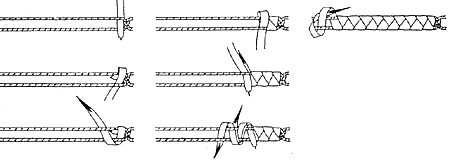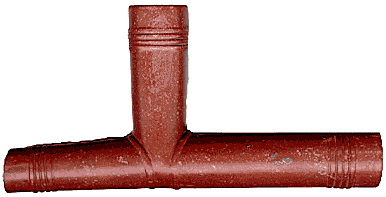This is an image of a porcupine quilled stem from a Plains-style pipe. While most pipes have plain stems, some like this one are highly decorated. The most common form of decoration on pipe stems is a colorful section of porcupine quillwork. The porcupine quills are dyed and woven into a single long strand using a technique commonly referred to as quill-plaiting. This long strand is then wrapped around the stem. As you can see, the work is very intricate and requires a great amount of skill and patience to create the complex designs on this stem.

Quill Plaiting Technique - Illustration from A Guide to Indian Quillworking
Learn more about porcupine quillwork
Although the pipestem illustrated is a work of art on its own, it is only one part of the pipe. The other part is the bowl which is made from red pipestone or catlinite. Most red pipestone comes from quarries in Minnesota. The quarries are considered a sacred site. The red stone is said to represent the blood of the people. Generally, only Native Americans with the proper permits can legally quarry the stone.
Pipe bowl made of red pipestone
While sometimes referred to as a "peace pipe," the pipe is actually used for religious purposes to pray. The pipe has great power and it is said that whatever is prayed for with the pipe will come true. The pipe must always be treated with great respect. When not in use, most Plains ceremonial pipes are stored with the bowl separated from the stem.
The pipe was and is used by many tribal groups throughout North America. Some researchers say the use of the pipe predates Christianity. Most groups have a legend which explains how the pipe was brought to them. The Lakota tell the story of the White Buffalo Woman in which a beautiful woman brings the pipe to the people and instructs them in its use. It is said that when she left, she turned into a white buffalo.
The overall length of this stem is 23 inches. The stem is made of ash and is decorated with dyed porcupine quills, red-dyed horsehair, and feathers of the mallard duck. This bowl and stem was made in 1995.
Last modified on April 29, 2019 |
|
Copyright ©1997-2019 Matoska Trading Company |
